You probably already know that there are two major categories of telescopes: Refractors and Reflectors. But which is better for beginners? Before you decide for yourself, it’s important to understand the differences between the two. In this article, we’ll start with a quick summary of the basic features of reflecting vs. refracting telescopes. Then we’ll go through 7 key differences between them, to help you decide which type best fits your needs.
See also:
Basic Features: Reflecting vs. Refracting Telescopes
Before we dig into the pros and cons of reflecting vs. refracting telescopes … let’s start with the basics. What exactly are the key features that differentiate reflectors from refractors?
Refractor Telescopes – The “Classic” Telescope Design
If you ask the average person to describe a telescope, they will probably be thinking of a refractor telescope. Why? Because it’s by far the most classic-looking type of telescope. Think about George Washington, at the height of the American Revolution, looking through his spyglass telescope to monitor the movements of British troops – this is a classic example of a refracting telescope.
The refracting telescope was most likely invented in the mid-1500’s by Leonard Digges (although Galileo Galilei is often credited as the inventor of the telescope). Its design is really pretty straightforward: A refractor is made of a long optical tube with a convex glass lens at the main opening. The light enters the telescope through this lens, then exits the telescope through the eyepiece for viewing.
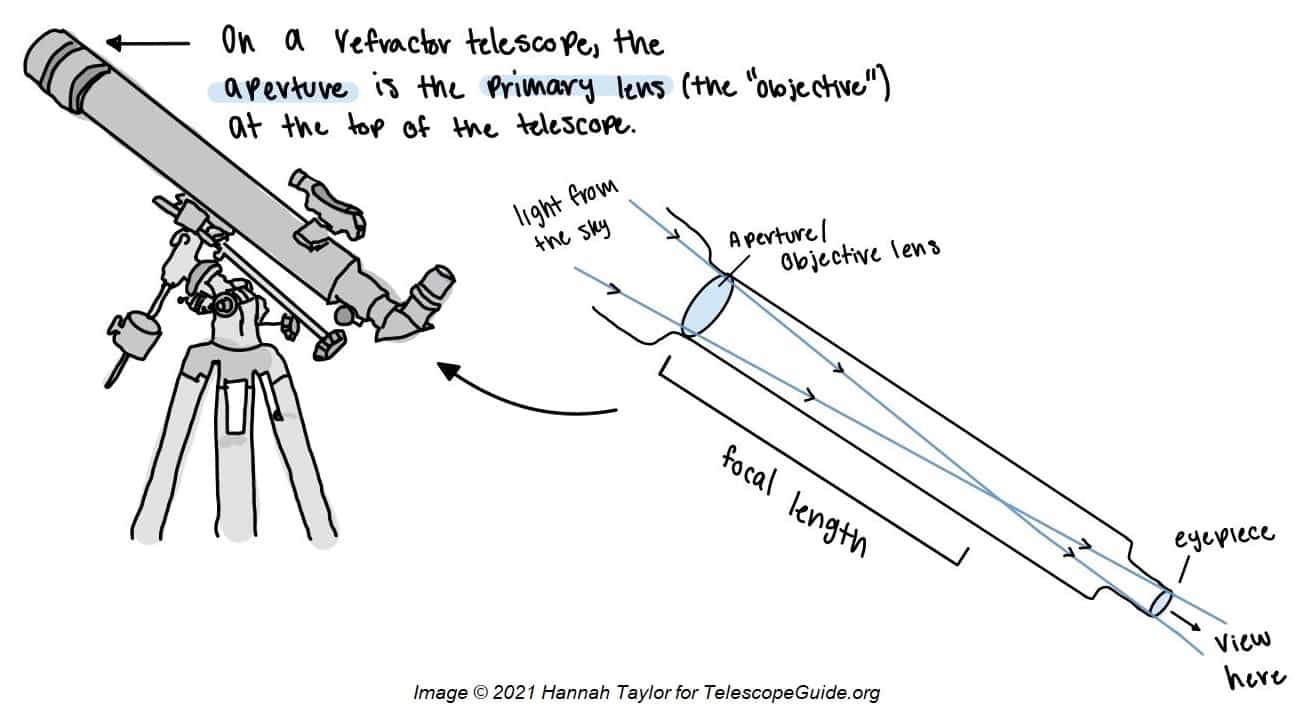
The glass lens “refracts” (or bends) the light so that it reaches a focal point. The size of the lens (known as the telescope’s “objective”) determines the amount of light the telescope can collect. (This is also referred to as the telescope’s “aperture”.) The focal length of the telescope, divided by the focal length of the eyepiece, determines the amount of magnification. The focal length also determines the field of view. (A shorter focal length provides a wider field of view, measured in degrees.)
Refractors come in many varieties – and they can be optimized for a variety of usage scenarios including astrophotography, research, and visual astronomy.
Here’s a real-world example of a refractor telescope – this is similar to the one sketched in the image above. This one sits on an alt-azimuth mount, while the sketch above shows a German equatorial mount. Both have a 90-degree diagonal, which redirects the light upwards to the eyepiece.
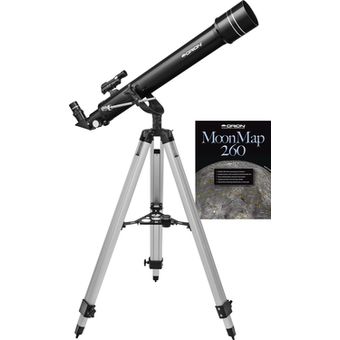
Image Credit: Orion (Used with Permission)
Telescope shown: Orion Observer II 70mm (See it on Telescope.com)
Reflector Telescopes Came Along Later, Introducing Newton’s Innovative Mirror-Based Design
Reflecting telescopes introduced a new concept – using mirrors as the primary way to gather light and redirect it to a focal point. Unlike refracting telescopes, reflectors do not utilize a glass objective lens – instead, a large curved mirror is situated at the base of the telescope.
This primary mirror (whose diameter is the size of the telescope’s aperture) plays the role of bouncing light rays back towards one or more additional mirrors, until the light eventually exits the telescope through the eyepiece.
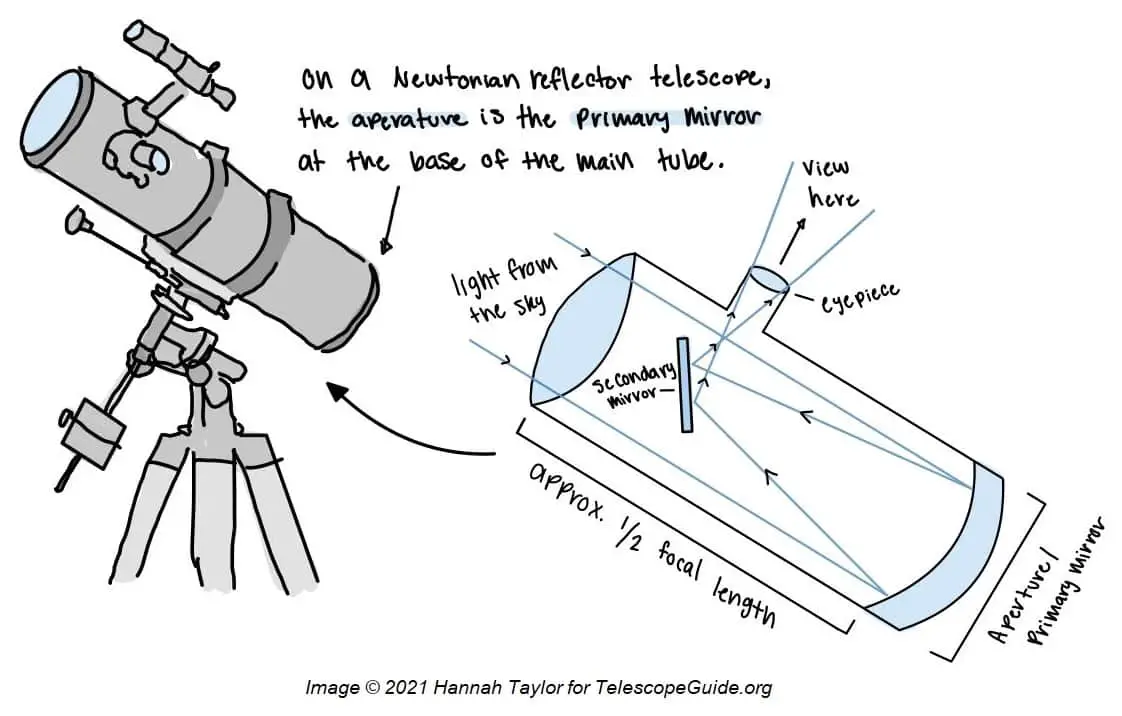
Reflector telescopes have many sub-types which differ from each other in the number of mirrors, shape of mirrors, and other details. These include the classic Newtonian telescope (named after Isaac Newton), Dobsonian telescopes, compound or catadioptric telescopes (like the Schmidt-Cassegrain telescope which is a popular compound reflector), and more. But the one thing they all have in common is that they utilize a large primary mirror as the aperture of the telescope (its main light-collecting component).
Here’s a real-world example of a reflector telescope – this is the same one sketched in the image above. This one also sits on a German equatorial mount. Notice the location of the eyepiece. It’s towards the top of the telescope, because that’s the location of the secondary mirror.
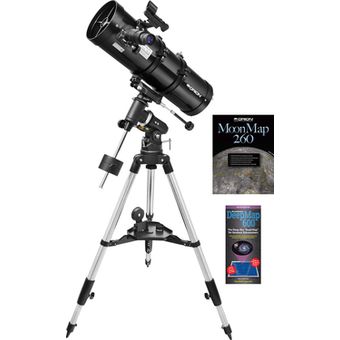
Image Credit: Orion (Used with Permission)
Telescope shown: Orion SpaceProbe 130ST (See it on Telescope.com)
Here’s another real-world example – notice how the telescope’s optical tube is open vs. enclosed. Also notice that when you peer inside the telescope from the top of the optical tube, you can see the sky’s reflection in the primary mirror. (In this case, you can see trees reflected in the mirror.)
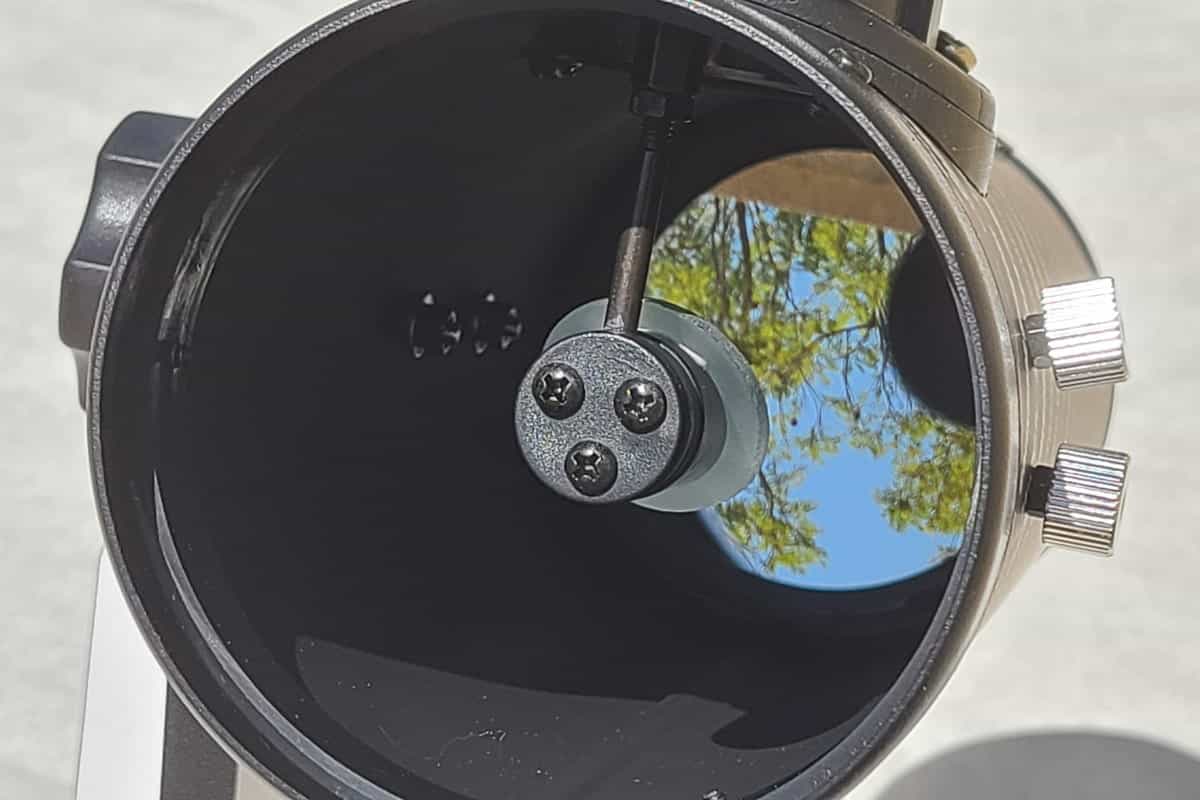
Image Credit: Richard Bartlett / TelescopeGuide.org
7 Key Differences: Choosing Between a Reflecting vs. Refracting Telescope
Summary: Which is Better?
For a quick summary of the 7 key differences, take a look at the table below. But keep in mind there are a lot nuances to consider. Keep reading further for more discussion of each category.
| Category | Winner | Why? |
|---|---|---|
| 1. Price & affordability | Reflectors | Mirrors are less expensive for larger aperture sizes. For smaller telescopes, refractors still offer good value. |
| 2. Maintenance & ease of use | Refractors | Reflectors require more maintenance of their internal components. |
| 3. Size & portability | Reflectors | Large reflectors are more compact than refractors of similar aperture size. |
| 4. Optical performance & clarity | Either, if high-quality | You can get stunning images with either a high-quality achromatic/apochromatic refracting lens, or a reflector with one or more true parabolic mirrors and high-quality manufacturing. |
| 5. Deep-sky visual astronomy | Reflectors | Large reflectors make it possible for the average astronomer to view distant galaxies, nebulae, and star clusters. |
| 6. Astro-photography | High-quality refractors | You don't need a large telescope for astrophotography. We recommend a triplet APO refractor with a fast focal ratio. |
| 7. Traveling | Refractors | Can't beat a 70-100mm traveling refractor. |
1. Price & Affordability (Winner: Reflectors… For Larger Sizes)
The #1 advantage of reflecting telescopes is their affordability. This is because large mirrors are cheaper to manufacture than high-quality glass for large refracting lenses.
This is especially true as you get towards very large apertures and you are aiming for the highest quality optical performance. A very large “triplet” apochromatic refractor is exponentially more expensive than a same-size reflecting telescope.
However, this general rule only applies to larger aperture telescopes. It’s not 100% true for much smaller telescopes. Sometimes, for very small telescopes (for example, below 100mm), refractors can offer the superior value. For smaller sizes, reflecting telescopes can be more expensive to manufacture due to their being more complex, with more sensitive internal components, compared to their refracting counterparts. Once you consider maintenance and other factors, this can easily tip the scales towards refractors in terms of overall value.
At TelescopeGuide.org, we generally recommend you get the largest aperture size (a) that you can afford, and (b) that fits your needs in terms of portability and usability. For this reason – we often recommend people consider starting their astronomy journey with a decent-sized Dobsonian telescope, or a tabletop reflector telescope. (Both are great choices for a first telescope.)
Bottom line: If you’re on a budget and looking for a good aperture size, reflectors usually offer more “bang for the buck”. However, if you’re on a budget and looking for a smaller telescope, you should still consider refractors a good value.
2. Maintenance & Ease of Use (Winner: Refractors)
One clear benefit of refracting telescopes is that they rarely (if ever) require maintenance. The lens attaches securely to the optical tube, and it rarely moves enough to require adjustment. Additionally, there are no complex internal components that can come out of alignment.
Thanks to the simplicity of their design, refracting telescopes are drop-dead easy to use and maintain. If your priority is ease and convenience, and you are looking to be able to pull out your telescope anytime and use it in minutes, a refractor telescope offers clear advantages.
This is not quite the case with reflectors. Reflectors are a little more complicated. Whether it’s a simple Newtonian reflector, or a more complex catadioptric or compound telescope, it will sometimes require a procedure known as collimation.
When you collimate a telescope, you need to make fine adjustments to the alignment of the optical elements. Collimation can take time and effort away from viewing. (At least until you get good at it. Experienced astronomers can collimate a telescope in minutes.)
For beginners especially, refractors are a great choice because they are always ready to go. But even for advanced users, a refractor offers simplicity and convenience that may be compelling.
Bottom line: Refractors are drop-dead simple to use – which makes them perfect for true beginners. Reflectors will usually require a bit more maintenance.
3. Size & Portability (Winner: Reflectors… Usually)
So, take a good look at the diagrams above in the article. Did you notice anything about the focal distance of the refractor vs. the reflector?
Size of the Optical Tube
For refracting telescopes, the overall length of the telescope’s optical tube is a bit longer than the focal distance. (It’s not quite exactly the same, because the focal point is actually a little ahead of the eyepiece.)
For reflecting telescopes, the optical tube is much smaller and more compact. This is because the focal point is located beyond the secondary mirror – which makes it possible for the telescope length to be about 1/2 the focal distance or even smaller. (For a classic Newtonian reflector, it’s about 1/2. For a compound telescope, it can be even smaller because the light is redirected multiple times.)
With that said … this size difference really only matters once you start looking at larger telescopes. At the beginner stage, the size for lower-end refractors is really not a big deal.
However, as you get into more powerful refractors with larger lenses and longer focal lengths, these telescopes can get really big and heavy, making them more difficult to transport, balance, and maneuver. And, since the eyepiece is always at the far end of the main telescope tube, larger refractors can make for awkward positioning of the eyepiece.
Weight
Another major consideration is the weight of the telescope. And again, reflectors will start to outperform refractors as you start getting into the larger aperture sizes. Manufacturing a high-quality glass lens in an ultra-large size requires some serious glass to compose the elements of the lens. And the heavier the telescope, the more you’ll need to spend buying a mount that can adequately support it.
Bottom line: If you’re looking for a compact, portable telescope with a large aperture, you should definitely consider getting a reflector. For smaller telescopes, you could really go either way.
4. Optical Performance & Clarity (Winner: High-Quality Refractors or Reflectors)
In visual astronomy, there is nothing quite like getting a clear, crisp, high-contrast view that’s free of any kinds of aberration or distortion. Both refractors and reflectors can offer stunning views, as long as they are manufactured with high-quality components.
Disclaimer: Optical performance is a very complicated topic. In this section we’re going to keep it somewhat simple and focus on the basics.
Low-quality refractors suffer more from chromatic aberration
Inexpensive refractor telescopes often use a simple refracting lens, made of a single piece of glass. The challenge with this is that it introduces a blurring of certain color wavelengths in the image, called chromatic aberration. (Why? Different wavelengths of light require slightly different focal lengths after refraction.)
For smaller refractors, this is not really a big deal. However, it starts to become more important as you go beyond lower-powered refractors.
Chromatic aberration can be mitigated or reduced using a high-quality achromatic objective lens (sometimes in combination with a fringe filter) or – even better – with an apochromatic lens (a.k.a. APO lens) consisting of two matched glass elements (a “doublet”) or three elements (a “triplet”).
These higher-quality refractors provide ultra-sharp image quality – making them a great choice for detailed viewing of solar system objects. High-quality refracting telescopes also make for stunning astrophotography.
Low-quality reflectors suffer more from spherical aberration
Because reflecting telescopes reflect light instead of refracting it, they don’t need to worry about chromatic aberration like refractors do.
However, reflectors can still suffer from a phenomenon known as spherical aberration, where distortion is caused by differences in the focus of light across the surface of the mirrors. (Note: Refractors can suffer from this too, but the higher quality lenses do a good job correcting for it.)
The cheapest kind of mirror to manufacture is spherical in shape. However, spherical mirrors result in higher spherical aberration. High-quality reflectors employ one or more parabolic mirrors. And, a “true” parabolic mirror requires extremely high-precision manufacturing, making it more expensive. (And note: There are many differences between the miscellaneous sub-types of reflectors. Not enough time to go into it here.)
Bottom line: If you’re looking for the sharpest possible images, be prepared to buy a higher quality telescope, regardless of whether it’s refracting or reflecting. For refractors, consider getting an achromatic or apochromatic lens. For reflectors, look for true parabolic mirrors and high-quality engineering.
5. Seeing Deep-Sky Galaxies, Star Clusters, and Nebulae (Winner: Large Reflectors)
For visual astronomy, we generally recommend you get the largest aperture you can afford. (As long as the telescope is a good fit for your needs in other ways – especially in terms of size, weight, portability, and ease of use.)
If you want to extend the “reach” of your telescope into deep space, then the size of the aperture is the most important factor. Remember: The amount of light a telescope can collect is related to the square of the aperture size. So, for example, a 10″ telescope, which is only 2″ wider than a 8″ telescope, can collect 56% more light!
For refractors, as the diameter of the aperture increases, the cost and bulk of the lens increases exponentially faster. For this reason, most amateur astronomers prefer reflector telescopes for deep-sky visual astronomy.
In fact, when it comes to large aperture sizes, reflectors are pretty much the only game in town for the average amateur. You will have a hard time finding an affordable high-quality refractor with a 10″ aperture. But, if you’re looking for a 10″ reflector, you’ll find plenty of great options, like the Orion SkyQuest XT10.
A larger aperture means more light collection ability, which means you’ll be able to see fainter, more distant objects in the sky – including galaxies, nebulae, and globular clusters. And, when you’re viewing things within our own solar system, like the rings and moons of Saturn, you’ll be able to see stunning details that are impossible with smaller sizes.
(But, one word of caution: Don’t go overboard. You don’t want to get something so big that it ends up collecting dust in your attic. Make sure you know the telescope size that you can best handle.)
Bottom line: For deep-sky visual astronomy, there is no substitute for a large-aperture reflector telescope.
6. Astro-Imaging Capability (Winner: High-Quality Refractors)
Most amateur astrophotographers prefer the simplicity of a high-quality apochromatic (APO) refractor telescope. (There are also some great reflector options for astrophotography, but refractors have some key advantages.)
Why? Well, a few reasons:
First, you don’t need a large aperture for astrophotography. That might be surprising, but it’s true.
For visual astronomy, you do need a large aperture, because you need to get as much light as possible into the telescope (all at once) so you can see the target with your eyes.
However, with astrophotography, what you really care about is the amount of light per pixel – so the speed of the telescope becomes more important. A “fast” telescope has a low focal ratio (ideally f/6 or lower for astrophotography). (And remember, you get the focal ratio by dividing the focal distance by the aperture size.) So, for astrophotography, a fast 80mm APO refractor can outperform a larger but slower telescope.
Second, with astrophotography, smaller telescopes are often preferable because they are lighter. And lighter telescopes require less costly mounting systems.
Astrophotography mounting systems can get expensive… in a hurry. In fact, for astrophotography, the mount is arguably just as important as the telescope. Astrophotographers need to be able to take multiple long-exposure shots while keeping the telescope perfectly trained on their target.
Smaller telescopes are much lighter and therefore can follow a moving object more cleanly than its bigger brothers and sisters. A comet moving across the night sky can be followed automatically if you have the right settings. With a lighter telescope, you can use a less expensive mount and still get smooth control over the movement.
Bottom line: Apochromatic (APO) refractors are fantastic for astrophotography. You don’t need it to be large; instead, you want something lightweight with high optical quality and a fast focal ratio.
7. Traveling with Your Telescope (Winner: Refractors)
Last but not least, if you are looking for a small telescope to take with you “on the go”, a reflector is usually not worth the hassle.
There are plenty of fantastic small refractors available, designed with special lightweight tubes for traveling. (Both Celestron and Orion make excellent entry-level traveling refractors. You’ll find them in a variety of sizes and configurations, with some basic models below $100 and below $200.) These telescopes are versatile, drop-dead easy to use, require zero maintenance, and can fit in a backpack.
Bottom line: If you’re looking for a traveling telescope, it’s hard to beat a good 70-100mm traveling refractor.
Final Thoughts | Reflecting vs. Refracting Telescopes
So, now that you’ve read this far, which is better, really? People have debated this question since … well, pretty much the invention of the telescope. (But not quite, since refractors were invented about 50 years before reflectors.)
Hopefully this article has helped you see there are clear pros and cons for both types of telescopes.
Bottom line: There is no single best telescope type. It’s a personal choice, and it really depends on a number factors, your budget, and how you plan to use your telescope. Each has its place in astronomy.
Whichever way you end up going, we hope this article helped you make a more informed decision.
(Also, if you liked this article, please share it using the social media buttons below!)




